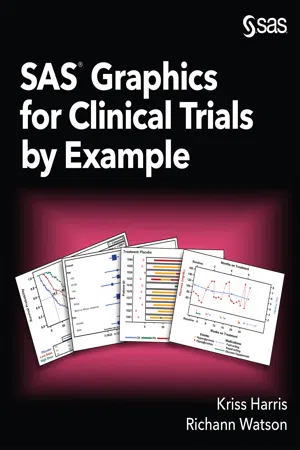
- 268 pages
- English
- ePUB (mobile friendly)
- Available on iOS & Android
SAS Graphics for Clinical Trials by Example
About this book
Create industry-compliant graphs with this practical guide for professionals
Analysis of clinical trial results is easier when the data is presented in a visual form. However, clinical graphs must conform to specific guidelines in order to satisfy regulatory agency requirements. If you are a programmer working in the health care and life sciences industry and you want to create straightforward, visually appealing graphs using SAS, then this book is designed specifically for you. Written by two experienced practitioners, the book explains why certain graphs are requested, gives the necessary code to create the graphs, and shows you how to create graphs from ADaM data sets modeled on real-world CDISC pilot study data.
SAS Graphics for Clinical Trials by Example demonstrates step-by-step how to create both simple and complex graphs using Graph Template Language (GTL) and statistical graphics procedures, including the SGPLOT and SGPANEL procedures. You will learn how to generate commonly used plots such as Kaplan-Meier plots and multi-cell survival plots as well as special purpose graphs such as Venn diagrams and interactive graphs. Because your graph is only as good as the aesthetic appearance of the output, you will learn how to create a custom style, change attributes, and set output options. Whether you are just learning how to produce graphs or have been working with graphs for a while, this book is a must-have resource to solve even the most challenging clinical graph problems.
Frequently asked questions
- Essential is ideal for learners and professionals who enjoy exploring a wide range of subjects. Access the Essential Library with 800,000+ trusted titles and best-sellers across business, personal growth, and the humanities. Includes unlimited reading time and Standard Read Aloud voice.
- Complete: Perfect for advanced learners and researchers needing full, unrestricted access. Unlock 1.4M+ books across hundreds of subjects, including academic and specialized titles. The Complete Plan also includes advanced features like Premium Read Aloud and Research Assistant.
Please note we cannot support devices running on iOS 13 and Android 7 or earlier. Learn more about using the app.
Information
Chapter 1: Introduction to Clinical Graphics
1.1 Introduction to Output Delivery System Statistical Graphics
1.1.1 Understanding the Basic: Statistical Graphics Procedures
1.1.1.1 Overview of the SGPLOT Procedure
proc sgplot <options>;
<… plot statements …> / <options>;
run;
1.1.1.2 Overview of the SGPANEL Procedure
proc sgpanel <options>;
panelby variable / <options>;
<… plot statements …> / <options>;
run;
1.1.1.3 Overview of the SGSCATTER Procedure
Table of contents
- About This Book
- About These Authors
- Acknowledgments
- Chapter 1: Introduction to Clinical Graphics
- Chapter 2: Using SAS to Generate Graphs for Adverse Events
- Chapter 3: Using SAS to Generate Graphs for Data Collected Over Time
- Chapter 4: Using SAS to Generate Graphs for Exposure and Patient Disposition
- Chapter 5: Using SAS to Generate Graphs for Time-to-Event Endpoints
- Chapter 6: Using SAS to Generate Graphs for Tumor Response
- Chapter 7: Using SAS to Generate Special Purpose Graphs
- Chapter 8: Building the Seemingly Impossible
- Chapter 9: Selecting the Ideal Style, Output Format, and Graphical Options
- 9.1 Introduction to Styles, Output Format, and Graphical Options